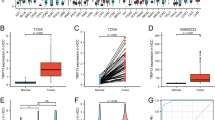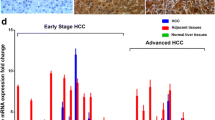Abstract
Introduction
Hepatocellular carcinoma (HCC) is one of the most common malignancies worldwide and is a leading cause of cancer mortality with over 90% of HCC patients succumbing to the disease. Current systemic therapies have had no measurable impact on survival in this disease; however there are small subsets of patients who benefit from systemic therapy who have been difficult to identify. Improvements in patient stratification and the development of biological therapies have resulted from the elucidation of the molecular mechanisms integral to tumor development and progression. Recent studies have found that COX-2 and EGFR are frequently inappropriately expressed in HCC compared to normal liver expression; however the presence of surface receptors does not always mean that the downstream pathway is active. In this study, we investigate the incidence and impact of activated EGFR downstream messengers phosphorylated akt (pakt) and/or phosphorylated MAPK (pMAPK) on survival in patients with HCC.
Method
Thirty consecutive HCC patients treated at a single institution were retrospectively reviewed. Patient data including age, sex, Child’s score, histological type, grade, stage, and survival were analyzed. Immunohistochemical staining was performed on formalin fixed, paraffin embedded tissues using monoclonal antibodies to COX-2, EGF receptor, pMAPK, and pakt. Histoscores were determined for each marker and evaluated for impact in survival, stage, and tumor grade.
Results
The median age was 67 years (39–83) and 67% of patients were male. Median survival was 9.8 months (1–47 months) for the whole group. COX-2 and EGFR expression was present in 90 and 67% of the tumors, respectively. Expression of activated downstream EGFR messengers was present in 53% of tumors (pMAPK 41%, pakt 31%). Median survival was significantly better in patients with downstream messenger expression, 24.4 months, compared to no expression, 4.7 months (P = 0.03). These groups were matched in age, stage, and Child’s score.
Conclusion
COX-2 and EGFR expression are commonly seen in HCC. Activated downstream EGFR expression is also common in HCC and is a predictor of improved survival. There may be a therapeutic role for EGFR tyrosine kinase inhibitors in this subset of patients and further investigation is warranted.

Similar content being viewed by others
References
Bosch FX, Ribes J, Diaz M, et al. Primary liver cancer: worldwide incidence and trends. Gastroenterology 2004; 127:5–16
Seeff LB. Introduction: the burden of hepatocellular carcinoma. Gastroenterology 2004; 127:1–4
El-Serag HB. Hepatocellular carcinoma: recent trends in the United States. Gastroenterology 2004; 127:27–34
Chen MF, Hwang TL, Jeng LB, et al. Postoperative recurrence of hepatocellular carcinoma. Two hundred five consecutive patients who underwent hepatic resection in 15 years. Arch Surg 1994; 129:738–42
Bismuth H, Majno PE, Adam R. Liver transplantation for hepatocellular carcinoma. Semin Liver Dis 1999; 19:311–22
Liu CH, Chang SH, Narko K, et al. Overexpression of cyclooxygenase-2 is sufficient to induce tumorigenesis in transgenic mice. J Biol Chem 2001; 276:18563–9
Cheng J, Imanishi H, Amuro Y, et al. NS-398, a selective cyclooxygenase 2 inhibitor, inhibited cell growth and induced cell cycle arrest in human hepatocellular carcinoma cell lines. Int J Cancer 2002; 99:755–61
Nzeako UC, Guicciardi ME, Yoon JH, et al. COX-2 inhibits Fas-mediated apoptosis in cholangiocarcinoma cells. Hepatology 2002; 35:552–9
Cervello M, Foderaa D, Florena AM, et al. Correlation between expression of cyclooxygenase-2 and the presence of inflammatory cells in human primary hepatocellular carcinoma: possible role in tumor promotion and angiogenesis. World J Gastroenterol 2005; 11:4638–43
Cianchi F, Cortesini C, Bechi P, et al. Up-regulation of cyclooxygenase 2 gene expression correlates with tumor angiogenesis in human colorectal cancer. Gastroenterology 2001; 121:1339–47
Jiang MC, Liao CF, Lee PH. Aspirin inhibits matrix metalloproteinase-2 activity, increases E-cadherin production, and inhibits in vitro invasion of tumor cells. Biochem Biophys Res Commun 2001; 282:671–7
Murono S, Yoshizaki T, Sato H, et al. Aspirin inhibits tumor cell invasiveness induced by Epstein-Barr virus latent membrane protein 1 through suppression of matrix metalloproteinase-9 expression. Cancer Res 2000; 60:2555–61
Liebmann C. Regulation of MAP kinase activity by peptide receptor signalling pathway: paradigms of multiplicity. Cell Signal 2001; 13:777–85
Blank SV, Chang R, Muggia F. Epidermal growth factor receptor inhibitors for the treatment of epithelial ovarian cancer. Oncology (Huntingt) 2005; 19:553–9; discussion 560–2, 567
Pomerantz RG, Grandis JR. The epidermal growth factor receptor signaling network in head and neck carcinogenesis and implications for targeted therapy. Semin Oncol 2004; 31:734–43
Tedesco KL, Lockhart AC, Berlin JD. The epidermal growth factor receptor as a target for gastrointestinal cancer therapy. Curr Treat Options Oncol 2004; 5:393–403
Tokunaga A, Onda M, Okuda T, et al. Clinical significance of epidermal growth factor (EGF), EGF receptor, and c-erbB-2 in human gastric cancer. Cancer 1995; 75:1418–25
Zhou BP, Hung MC. Dysregulation of cellular signaling by HER2/neu in breast cancer. Semin Oncol 2003; 30:38–48
Jackson JG, St Clair P, Sliwkowski MX, et al. Blockade of epidermal growth factor- or heregulin-dependent ErbB2 activation with the anti-ErbB2 monoclonal antibody 2C4 has divergent downstream signaling and growth effects. Cancer Res 2004; 64:2601–9
Hamilton M, Wolfman A. Oncogenic Ha-Ras-dependent mitogen-activated protein kinase activity requires signaling through the epidermal growth factor receptor. J Biol Chem 1998; 273:28155–62
Ito Y, Takeda T, Sakon M, et al. Expression and clinical significance of erb-B receptor family in hepatocellular carcinoma. Br J Cancer 2001; 84:1377–83
Koga H, Sakisaka S, Ohishi M, et al. Expression of cyclooxygenase-2 in human hepatocellular carcinoma: relevance to tumor dedifferentiation. Hepatology 1999; 29:688–96
Zhao YN, Cao J, Wu FX, et al. [Expression and significance of EGF mRNA and EGFR mRNA in hepatocellular carcinoma]. Ai Zheng 2004; 23:762–6
Kira S, Nakanishi T, Suemori S, et al. Expression of transforming growth factor alpha and epidermal growth factor receptor in human hepatocellular carcinoma. Liver 1997; 17:177–82
Qiu DK, Ma X, Peng YS, et al. Significance of cyclooxygenase-2 expression in human primary hepatocellular carcinoma. World J Gastroenterol 2002; 8:815–7
Malik SN, Siu LL, Rowinsky EK, et al. Pharmacodynamic evaluation of the epidermal growth factor receptor inhibitor OSI-774 in human epidermis of cancer patients. Clin Cancer Res 2003; 9:2478–86
Malik SN, Bedolla RG, Hidalgo M, et al. Immunohistochemical determination of EGFR-tyrosine kinase inhibition in clinical samples. Methods Mol Med 2003; 85:135–40
Malik SN, Brattain M, Ghosh PM, et al. Immunohistochemical demonstration of phospho-Akt in high Gleason grade prostate cancer. Clin Cancer Res 2002; 8:1168–71
Jiang D, Yang H, Willson JK, et al. Autocrine transforming growth factor alpha provides a growth advantage to malignant cells by facilitating re-entry into the cell cycle from suboptimal growth states. J Biol Chem 1998; 273:31471–9
Javle MM, Tan D, Yu J, et al. Nuclear surviving expression predicts poor outcome in cholangiocarcinoma. Hepatogastroenterology 2004; 51:1653–7
Murono S, Inoue H, Tanabe T, et al. Induction of cyclooxygenase-2 by Epstein-Barr virus latent membrane protein 1 is involved in vascular endothelial growth factor production in nasopharyngeal carcinoma cells. Proc Natl Acad Sci USA 2001; 98:6905–10
Shiota G, Okubo M, Noumi T, et al. Cyclooxygenase-2 expression in hepatocellular carcinoma. Hepatogastroenterology 1999; 46:407–12
Sipeki S, Bander E, Buday L, et al. Phosphatidylinositol 3-kinase contributes to Erk1/Erk2 MAP kinase activation associated with hepatocyte growth factor-induced cell scattering. Cell Signal 1999; 11:885–90
Liu F, Qi HL, Chen HL. Regulation of differentiation- and proliferation-inducers on Lewis antigens, alpha-fucosyltransferase and metastatic potential in hepatocarcinoma cells. Br J Cancer 2001; 84:1556–63
Wang Q, Lin ZY, Feng XL. Alterations in metastatic properties of hepatocellular carcinoma cell following H-ras oncogene transfection. World J Gastroenterol 2001; 7:335–9
Tang P, Steck PA, Yung WK. The autocrine loop of TGF-alpha/EGFR and brain tumors. J Neurooncol 1997; 35:303–14
Hambek M, Baghi M, Strebhardt K, et al. STAT 3 activation in head and neck squamous cell carcinomas is controlled by the EGFR. Anticancer Res 2004; 24:3881–6
Gibson SB. Epidermal growth factor and trail interactions in epithelial-derived cells. Vitam Horm 2004; 67:207–27
Yokoi K, Kim SJ, Thaker P, et al. Induction of apoptosis in tumor-associated endothelial cells and therapy of orthotopic human pancreatic carcinoma in nude mice. Neoplasia 2005; 7:696–704
Mukohara T, Engelman JA, Hanna NH, et al. Differential effects of gefitinib and cetuximab on non-small-cell lung cancers bearing epidermal growth factor receptor mutations. J Natl Cancer Inst 2005; 97:1185–94
Lee CM, Lee RJ, Hammond E, et al. Expression of HER2neu (c-erbB-2) and epidermal growth factor receptor in cervical cancer: prognostic correlation with clinical characteristics, and comparison of manual and automated imaging analysis. Gynecol Oncol 2004; 93:209–14
Chakravarti A, Winter K, Wu CL, et al. Expression of the epidermal growth factor receptor and Her-2 are predictors of favorable outcome and reduced complete response rates, respectively, in patients with muscle-invading bladder cancers treated by concurrent radiation and cisplatin-based chemotherapy: a report from the Radiation Therapy Oncology Group. Int J Radiat Oncol Biol Phys 2005; 62:309–17
Altundag O, Altundag K, Morandi P, et al. Association between epidermal growth factor receptor mutation and improved survival in never-smokers with primary adenocarcinoma of the lung. Chest 2005; 127:2292
Author information
Authors and Affiliations
Corresponding author
Additional information
No part of this research has been published. There are no competing interests and no financial institutions or grants involved.
Rights and permissions
About this article
Cite this article
Foster, J., Black, J., LeVea, C. et al. COX-2 Expression in Hepatocellular Carcinoma is an Initiation Event; While EGF Receptor Expression with Downstream Pathway Activation is a Prognostic Predictor of Survival. Ann Surg Oncol 14, 752–758 (2007). https://doi.org/10.1245/s10434-006-9123-8
Received:
Revised:
Accepted:
Published:
Issue Date:
DOI: https://doi.org/10.1245/s10434-006-9123-8




